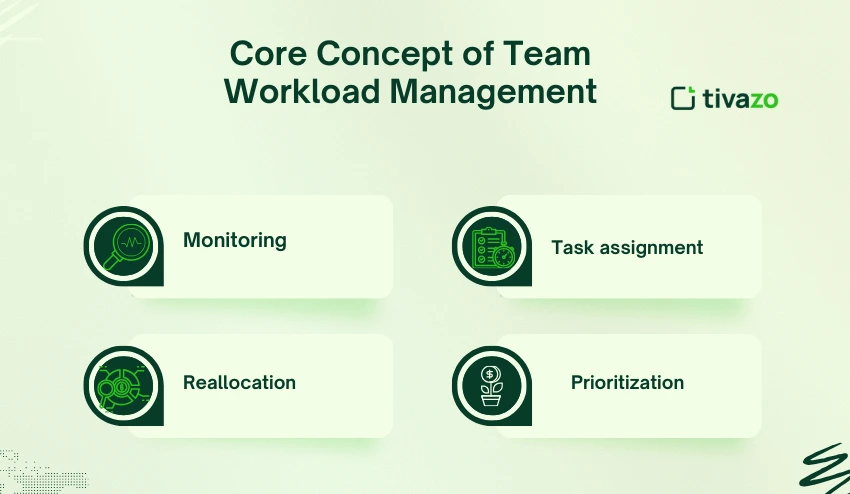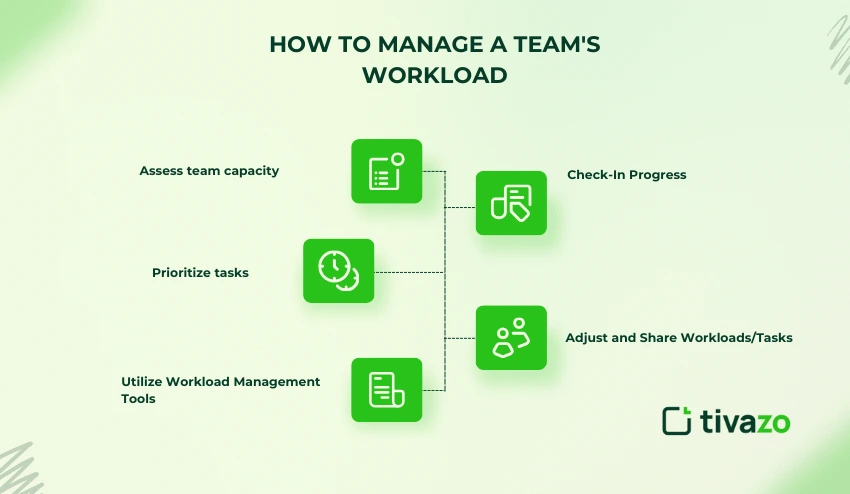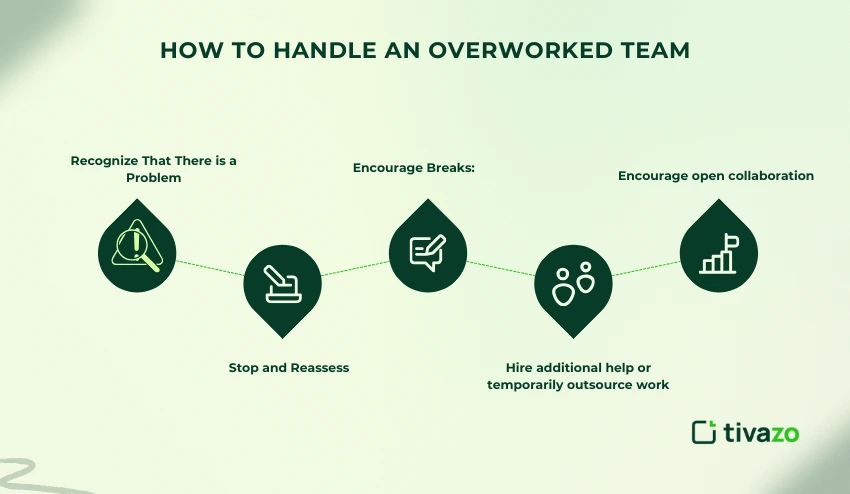In a fast-paced business environment, management of team workload is so much more than task allocation—it’s a key component of productivity, effectiveness, and employee well-being. Without a robust workload management strategy, teams could face burnout, missed deadlines, and poor performance. Successful workload management guides leaders to assign tasks fairly, observe team member progress, and see who might be overworked or underworked.
This blog will cover all that you need to know: methods, tools, real-world examples, and tactical plans for effective team workload management.
What is Team Workload Management?
Team workload management is the process of planning, assigning, tracking, and reallocating tasks to balance, optimize, and be productive. Workload management transfers task responsibilities to team members without their being overwhelmed with too much work or having nothing to do.
Core Concept of Team Workload Management
- Task assignment: when you distribute work with consider to skill set and capacity.
- Prioritization: the urgency or importance of various task assignments.
- Monitoring: methods and tools to measure workload progress.
- Reallocation: We can redistribute work when bottlenecks or overloading occur.

Why is Team Workload Management Important?
A managed workload has positive implications for employees and business outcomes. When leaders allocate tasks in teams properly, it promotes order, removes bottlenecks, and can foster a greater transparency culture in their organization. Teams are engaged in their work because they can see that work is being allocated fairly; deadlines seem realistic, and prioritization is clear. These opportunities can improve employee morale and increase long-term retention, because team members feel more engaged in their work and less like they are drained and undervalued.
From a business perspective, proper workload management can minimize operational risk, ensure resources are being used effectively, and ensure that operating within budget is achievable. In the end, understanding workload management means recognizing that disruptions, uncertainties, and challenges can create opportunities for improvement and innovation.
| Benefit | Impact |
| Increased Productivity | Teams are getting tasks done faster and more efficiently. |
| Reduced Burnout | Balanced workloads are helping to prevent employee stress and fatigue. |
| Higher Employee Satisfaction | Fair task allocation can promote trust and motivation. |
| Better Decision-Making | Managers can prioritize tasks as critical. |
| Improved Reputation for Project Success | . Deadlines are being met consistently. |
How to Manage a Team’s Workload
Structuring the workload, communicating with the team, and leveraging appropriate tools are all essential parts of the team workload management. When the workload is not structured correctly, teams can get overwhelmed, or worse, teams can be underutilized, which can lead to missed deadlines and depressed morale. Managing workloads effectively allows for an equitable distribution of tasks and allows a team to meet deadlines while utilizing the assets available.
Step 1: Assess team capacity
Identify skill sets, working hours, and availability. Knowing your resources allows you to delegate as equitably as possible based on individual strengths and weaknesses. If possible, use capacity planning tools or even worksheets to help determine the capacity and limits of the workload in order not to overwhelm them. In addition to capacity planning, take into account personal preferences and working habits, and prior performance
Step 2: Prioritize tasks
Use the Eisenhower Matrix in determining urgent vs important work. The Eisenhower Matrix provides a framework for prioritizing urgent and important deliverables of high value. When delegating, prioritize what your team will work on based on high-value deliverables, deferring or delegating low-priority tasks. Prioritizing these tasks will support the team to know that they are acting on what really matters!
Step 3: Utilize Workload Management Tools
Workload management tools, such as Asana, Trello, Monday.com, or Float, are a great way to visualize workloads, manage tasks, and set deadlines. These are great platforms to see who is responsible for what and see who is outlining their workload.
Step 4: Check-In Progress
Have a regular weekly check-in or status meeting to monitor where your team’s progress is and identify any bottleneck concerns early on. Use dashboards and reporting tools to provide real-time insights, so managers have visibility into when someone is overloaded or behind on their work.
Step 5: Adjust and Share Workloads/Tasks
Flexibility is important. When one team member is overloaded, redistribute the work to the available team members who can help share the work of the overloaded member. Encourage open communication within the team, so when a team member is reaching a bottleneck with their workload they can communicate this early. Being able to dynamically adjust team member roles helps keep team morale high and keep the project on track, allowing for both proactive team workload management and efficient workflow.

How to Handle an Overworked Team
When teams become overworked, they face declining productivity as well as declining morale. Here are some tips on how to manage a team workload management:
- Recognize That There is a Problem: One major component of managing an overworked team is recognizing signs of stress and burnout.
- Stop and Reassess: Stop the whole process of what they are doing and reassess basic goals. Remove anything that can be deemed unnecessary and get back to the basics.
- Encourage Breaks: Telling your employees to step away for 5-10 minutes can restore energy and concentration levels.
- Hire additional help or temporarily outsource work: Sometimes the workload becomes too much.
- Encourage open collaboration: Let employees express that they are unable to respond to their workloads.

What is a Workload Management Solution?
A workload management solution is a software or framework that allows organizations to balance, distribute, and manage assignments across team workload management.
Features of a Workload Management Solution:
- Task Management Visualization: Kanban boards or Gantt charts.
- Capacity Management: See who is overloaded or underloaded.
- Collaboration Tools: Real-time updates and communications.
- Automation: Automatic reminders and reporting.
- Examples: Float, Asana, ClickUp, and Monday.com.
How to Measure Team Workload
Keeping track of workload is necessary to keep things balanced and efficient.
- Important Metrics to Measure Workload
- Task Completion Rate – How many tasks are completed on time
- Utilization Rate – The percentage of productive hours to available hours.
- Overtime Tracking – Notice workloads beyond capacity.
- Indicators of Burnout – employee turnover, absenteeism, and lower performance.
Ways to measure
- Time-tracking software (Toggl, Clockify, etc.).
- Project management dashboards.
- Employee feedback surveys.
Best Ways to Manage Team Workload
The best strategies for managing the workload will involve planning and tools, as well as people management.
5 Best Practices
- Set Goals – Understand what your team is trying to accomplish.
- Balance Work – Make sure your team has a fair shot at the workload.
- Encourage Flexibility – Allow for remote or flexible hours.
- Use Automation – Minimize repetitive manual work.
- Provide Training – Use time to improve a team’s skills.
Three Strategies to Manage Your Workload
When it comes to managing team workload management, whether individually or with a team, there are three basic strategies to choose from:
- Prioritization (ABC method, Eisenhower Matrix)
- Time Blocking (scheduling time to complete tasks)
- Delegation (effectively allocating the work to be done based on people’s skills)
Each of these strategies can help you balance and complete the work you need to do.
Addressing an Unbalanced Workload with a Team
A work overload can lead to frustration and inefficiency!
What Steps Can You Take to Fix Imbalances in Workload?
- Recognize and Act on Overload Early: Make use of workload reports to act on workload overload early.
- Redistribute Work: Spread the workload based on individual or team capacity, as needed;
- Rotate and Assign Responsibilities: Rotate and assign responsibility for tasks to lessen the risk of repetitive strain.
- Encourage Open Discussion: Support team member(s) to openly raise concerns about their team workload management.
Examples of Overworkload
Overworkload can happen in all sectors of the team workload management:
- Marketing Teams: One person doing content and SEO.
- IT teams: One developer handling support tickets and building projects.
- Health care: A nurse doing 12+ hour shifts due to understaffing.
- Customer service: Limited staff covering several shifts.
All of these examples show that team workload management at a team level is incredibly important in minimizing burnout.
10 Proven Strategies for Effective Team Workload Management
Here’s a quick summary of 10 proven strategies:
- Assess the capacity of your team to understand how much work you can assign.
- Consider urgency and importance when assigning workloads.
- Use workload management software.
- Clearly communicate with your team.
- Monitor workloads every week.
- Reallocate workloads where necessary, in order to keep balanced workloads.
- Utilize realistic deadlines.
- Automate repetitive work.
- Allow flexibility with work schedules.
- Collect feedback from employees regularly.
Conclusion
Proper team workload management is important so that productivity, employee engagement, and the business’s overall success can be maintained. Keeping in mind team capacity, establishing clear task priorities, utilizing the right tools, and monitoring progress effectively can help to eliminate burnout and ensure equitable task distribution. Following the right workload management approach can undoubtedly assist teams in completing work on time while creating employee engagement, making them feel valued, and keeping them motivated with clear work goals.
Properly managing team work schedules supports organizations to use their resources wisely, minimize excitement, and improve decision-making. You can increase productivity with tactics like delegation, time blocking, and prioritization so your team stays focused on high-value activities. There are many modern workload management tools that are readily available that allow for insight, collaborative efforts, and provide teams with up-to-date awareness of their commitments, allowing for easy and quick movement and task re-distribution.
In the end, having team workload management practices down means lessening uncertainty, increasing team commitment, and supporting long-term sustainable growth. Organizations that adopt good workload management practices will be able to more effectively reach their objectives while staying in step with their longer-term aspirations.




